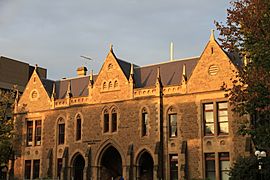Old Pathology Building Melbourne University facts for kids
Quick facts for kids Old Pathology Building |
|
|---|---|

Old Pathology Building, May 2013
|
|
| Alternative names |
|
| Etymology | Elisabeth Murdoch |
| General information | |
| Status | Complete |
| Type | Academic administration |
| Architectural style |
|
| Location | 156-292 Grattan Street, The University of Melbourne, Parkville Campus, Melbourne, Victoria |
| Country | Australia |
| Coordinates | 37°47′51″S 144°57′48″E / 37.79750°S 144.96333°E |
| Completed | 1885 |
| Owner | The University of Melbourne |
| Technical details | |
| Material | Bluestone walls; slate roof |
| Floor count | 2 |
| Design and construction | |
| Architecture firm |
|
| Official name: Old Pathology Building | |
| Type | State heritage (built) |
| Designated | 24 June 1992 |
| Reference no. | 914 |
| Significance | Registered |
The Old Pathology Building, now officially known as the Elisabeth Murdoch Building, is an important educational building. It is part of the University of Melbourne in Melbourne, Victoria, Australia. The building is located at 156-292 Grattan Street. It was built in 1885 by architects Reed, Henderson & Smart.
This building is very important to the State of Victoria because of its history and amazing design. It is a great example of early English Gothic architecture. The building has been used by the university for over 100 years. Because of its special value, it was added to the Victorian Heritage Register on June 24, 1992.
Contents
History of the Building
Classes at the University of Melbourne started in 1853. In 1862, the university opened Australia's very first medical school. This was a big step for medical education in the country.
In 1882, H. B. Allen became a professor at the university. He taught anatomy and pathology. Professor Allen was in charge of designing this new building. His main goal was to create a large and useful museum. He collected thousands of pathology specimens, which are like samples of diseases. These samples became the main part of the museum's collection.
Later, in 1930, Peter MacCallum took over from Professor Allen. He started the Society of Pathology and Experimental Science. MacCallum showed how important the university was for medical research. He also highlighted the need for more research labs in the 1950s.
What the Building Looks Like
The Old Pathology Building was built during the Victorian period. It uses a style called Neo-Gothic. It is a two-story building located on the university's Parkville campus.
This building is a great example of early English Gothic architecture. You can see this in its pointed arches and attached buttresses. These are special features of this style. The university wanted all its buildings to look similar. This is why they chose the Gothic style for this one.
The building was first designed to be the new medical school. It also housed the anatomy and pathology departments. The south part of the building was built first in 1885. Over the years, many more parts were added.
Architectural Details
The main parts of the building have bluestone bases and strong buttresses. The walls are made of stone, and the roof is steep with slate tiles. The north and west parts of the building are made of brick. They have windows with rounded or square tops.
The south part of the building shows the original idea for the "new medical school." It included the first Museum of Pathology. This museum kept Professor Allen's collection until the 1960s. The north part was planned for a dissecting room, preparation rooms, and a lecture hall for anatomy classes.
Design and Importance
The Old Pathology Building uses design features from the Victorian Academic Gothic style. These include pointed arches and attached buttresses. The university council wanted the building to fit in with other university buildings.
The outside of the whole building looks very similar. All the main rooms were planned around a central courtyard. This building is famous for being an expansion of Australia's first medical school. It played a very important role in training doctors in the 1800s. This was a time when many diseases were spreading quickly.
Images for kids
-
Bluestone used
-
Early English Gothic arches and window arches





